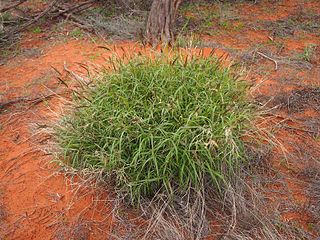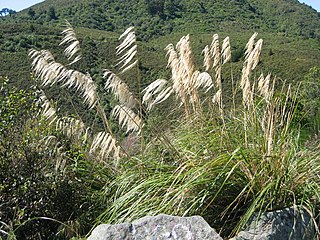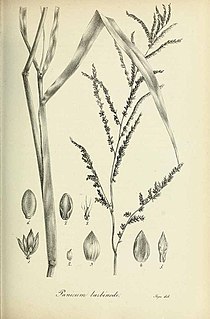Mat-grass or mat grass may refer to the following plant species:
- Nardus stricta , native to the Northern Hemisphere
- Axonopus fissifolius , native to the Americas, introduced elsewhere
- Phyla canescens , native to South America, introduced elsewhere
Mat-grass or mat grass may refer to the following plant species:

Ammophila is a genus of flowering plants consisting of two or three very similar species of grasses. The common names for these grasses include marram grass, bent grass, and beachgrass. These grasses are found almost exclusively on the first line of coastal sand dunes. Their extensive systems of creeping underground stems or rhizomes allow them to thrive under conditions of shifting sands and high winds, and to help stabilize and prevent coastal erosion. Ammophila species are native to the coasts of the North Atlantic Ocean where they are usually the dominant species on sand dunes. Their native range includes few inland regions, with the Great Lakes of North America being the main exception. The genus name Ammophila originates from the Greek words ἄμμος (ámmos), meaning "sand", and φίλος (philos), meaning "friend".

Goldenrod is a common name for many species of flowering plants in the sunflower family, Asteraceae, commonly in reference to the genus Solidago.

Cenchrus ciliaris is a species of grass native to most of Africa, southern Asia, southern Iran, and the extreme south of Europe (Sicily). Other names by which this grass is known include dhaman grass, anjan grass, koluk katai and buffelgrass.

Ammophila arenaria is a species of grass in the family Poaceae. It is known by the common names marram grass and European beachgrass. It is one of two species of the genus Ammophila. It is native to the coastlines of Europe and North Africa where it grows in the sands of beach dunes. It is a perennial grass forming stiff, hardy clumps of erect stems up to 1.2 metres (3.9 ft) in height. It grows from a network of thick rhizomes which give it a sturdy anchor in its sand substrate and allow it to spread upward as sand accumulates. These rhizomes can grow laterally by 2 metres in six months. One clump can produce 100 new shoots annually.

Tragus, commonly called bur gras, burr grass or carrot-seed grass, is a genus of plants in the grass family. It is native to Africa, Australia, and Eurasia with several species on islands in the Atlantic, Indian, and Pacific Oceans plus one species in Argentina.

The tropical grass species Cenchrus clandestinus is known by several common names, most often kikuyu grass, as it is native to the highland regions of East Africa that is home to the Kikuyu people. Because of its rapid growth and aggressive nature, it is categorised as a noxious weed in some regions. However, it is also a popular garden lawn species in Australia, New Zealand, South Africa and the southern region of California in the United States, as it is inexpensive and moderately drought-tolerant. In addition, it is useful as pasture for livestock grazing and serves as a food source for many avian species, including the long-tailed widowbird. The flowering culms are very short and "hidden" amongst the leaves, giving this species its specific epithet (clandestinus).

Ampelodesmos is a genus of Mediterranean plants in the grass family, which is known by the common names stramma, Mauritania grass, rope grass, and dis(s) grass. It is classified in its own tribe Ampelodesmeae within the grass subfamily Pooideae.

Lachnagrostis filiformis is a species of grass known by the common names Pacific bent grass, New Zealand wind grass, fairy grass, or blown-grass. It is native to Australia, New Zealand, and other Pacific Islands including New Guinea and Easter Island. While it is found in a wide variety of habitats, it seems particularly invasive in areas with damp soils, such as areas near bodies of water. It has been introduced to southern Africa, the United Kingdom, Taiwan, the southern United States and Mexico.
Arvense, a Latin adjective meaning in the fields, is the specific epithet of the following:

Paspalum dilatatum is a species of grass known by the common name dallisgrass, Dallas grass, or sticky heads. It is native to Brazil and Argentina, but it is known throughout the world as an introduced species and at times a common weed. Its rapid growth and spreading rhizomes make it an invasive pest in some areas. It is present in the southern half of North America, southern Europe, much of Africa, Australia, New Zealand, and many tropical and subtropical areas.

Sporobolus vaginiflorus is a species of grass known by the common names poverty grass, poverty dropseed, and sheathed dropseed.

Spartina patens, the saltmeadow cordgrass, also known as salt hay, is a species of cordgrass native to the Atlantic coast of the Americas, from Newfoundland south along the eastern United States to the Caribbean and northeast Mexico. It has been reclassified as Sporobolus pumilus after a taxonomic revision in 2014, but Spartina patens is still in common usage. It can be found in marshlands in other areas of the world as an introduced species and often a harmful noxious weed or invasive species.
Vossia is a monotypic genus in the grass family, found in Asia and Africa. The only known species is Vossia cuspidata, an aquatic grass native to Africa, and to Assam, Bangladesh, and northern Indochina. The common name is hippo grass.

Panicum repens is a species of grass known by many common names, including torpedograss, creeping panic, panic rampant, couch panicum, wainaku grass, quack grass, dog-tooth grass, and bullet grass. Its exact native range is obscure. Sources suggest that the grass is native to "Africa and/or Asia", "Europe or Australia", "Eurasia", "Australia", "Europe, Asia, and Africa", or other specific regions, including the Mediterranean, Israel, and Argentina. It is present in many places as an introduced species and often a noxious weed. It has been called "one of the world's worst weeds."

Austroderia is a genus of five species of tall grasses native to New Zealand, commonly known as toetoe. The species are A. toetoe, A. fulvida, A. splendens, A. richardii and A. turbaria. They were recently reclassified in 2011 from the genus Cortaderia, although their distinctiveness had been recognized as early as 1853.

Bothriochloa pertusa is a species of grass. It is widely used as a fodder and a graze for livestock.
Blue lettuce, wild blue lettuce, or common blue lettuce can refer to:

Brachiaria mutica is a species of grass known by the common names para grass, buffalo grass, Mauritius signal grass, pasto pare, malojilla, gramalote, parana, Carib grass, and Scotch grass. Despite its common name California grass, it does not occur in California; it is native to northern and central Africa and parts of the Middle East, where it is cultivated for fodder. It was introduced elsewhere and it is now cultivated throughout tropical regions of the world for this purpose.
"Onion weed" may refer to several species of plant that are either related to onions, have onion-like bulbs or flowers, or smell oniony or garlicky, and that are considered weeds outside their native ranges. These include:

Phyla canescens is a species of perennial herbaceous plant in the family Verbenaceae, native to South America. It has been introduced to Australia as an ornamental plant and low-maintenance lawn, but has become naturalised and is considered a serious environmental weed. It is known by several common names including carpet weed, Condamine couch, Condamine curse, fog fruit, frog fruit, hairy fogfruit, lippia, mat grass and no-mow grass.